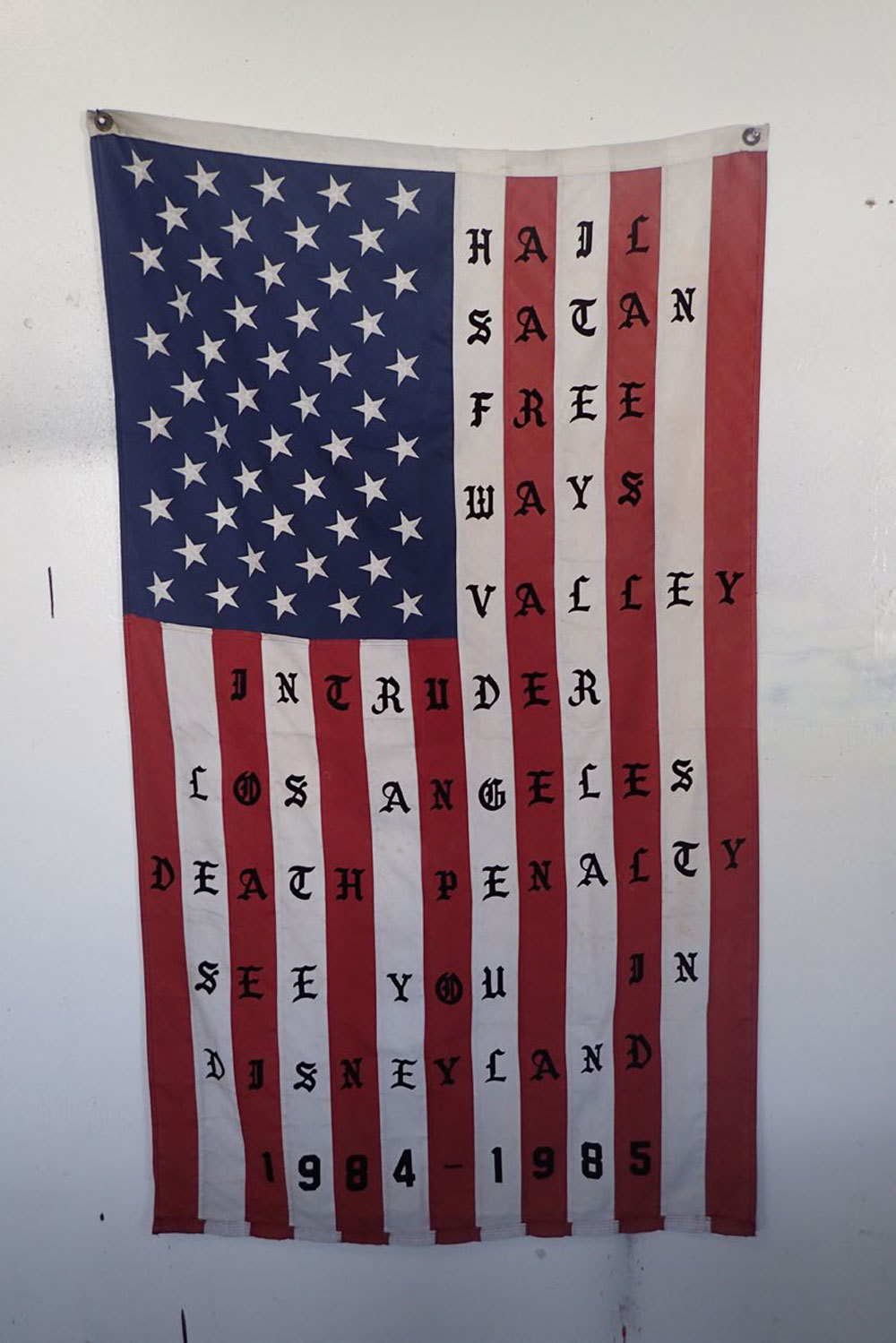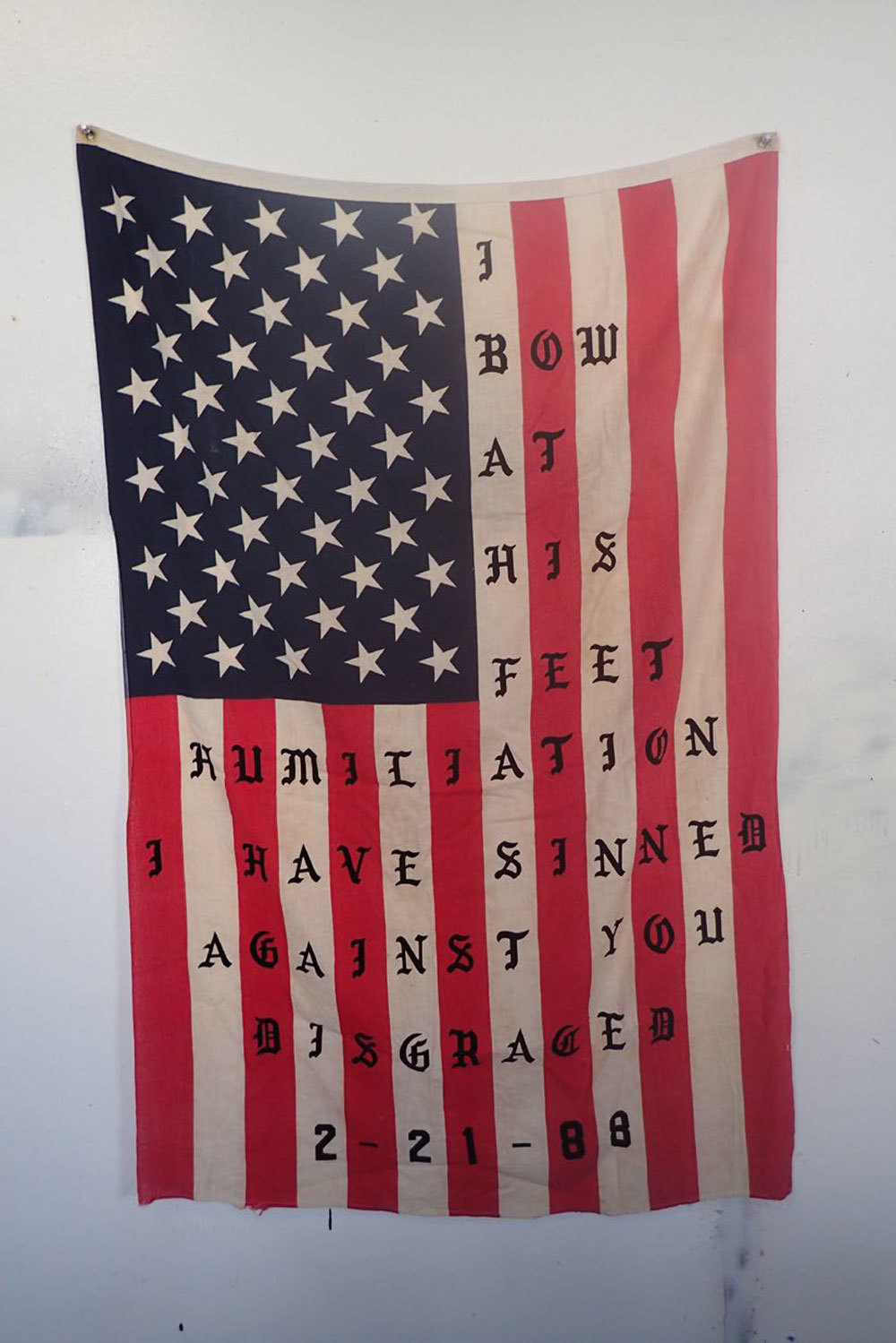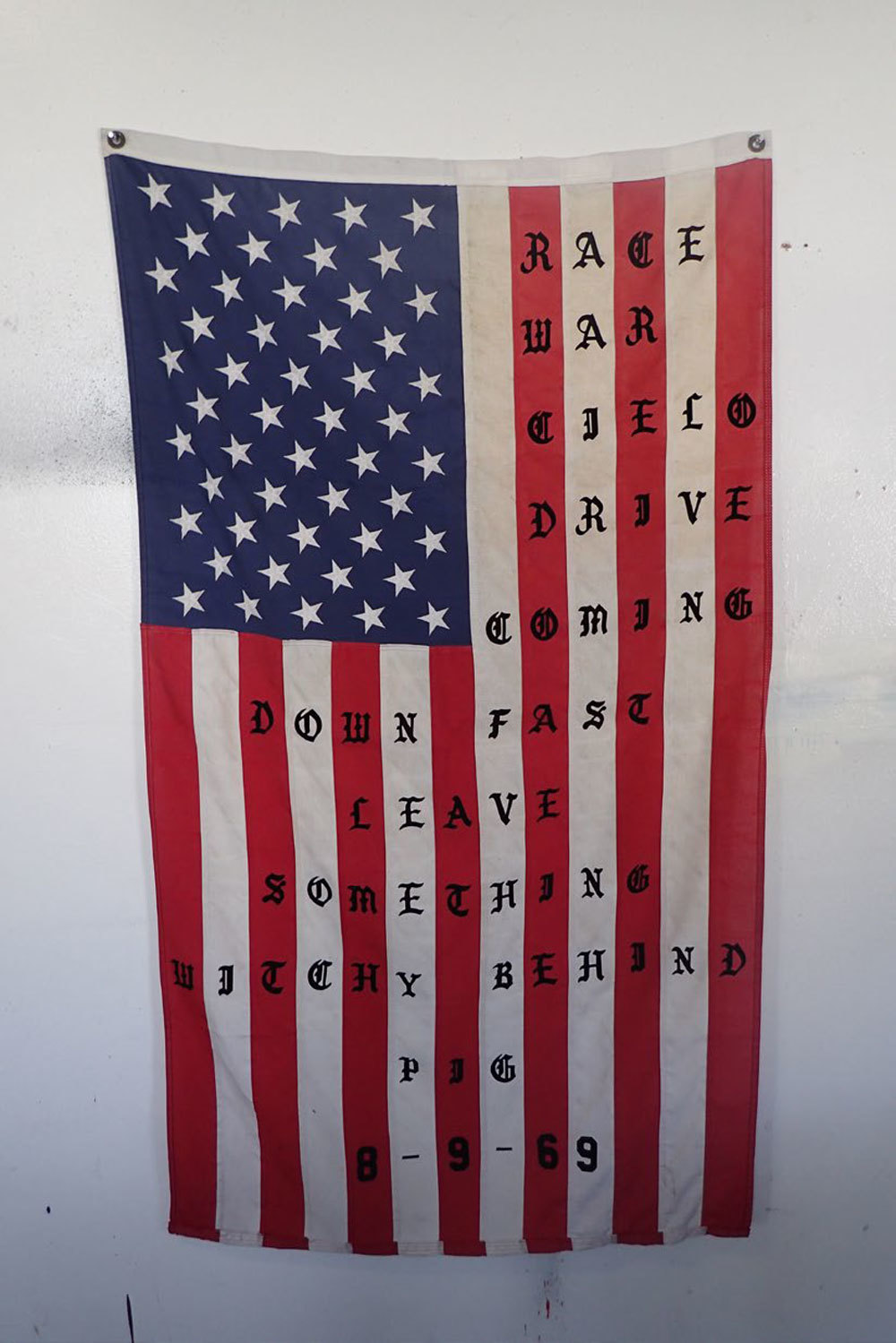You might have heard of Cali Thornill Dewitt, the Los Angeles-based artist who is best known these days for designing Kanye West’s Life of Pablo merchandise. Thornhill Dewitt’s visual trademark is using all-caps text written in iconic Gothic font — with phrases like “I feel like Pablo” and “We on an ultra light beam, this is a God dream.”
Now, Thornhill Dewitt is using his own words for a solo exhibition of brand new artworks (yes, using the same Gothic font) but this time, on American flags. The exhibition, 29 Flags, opening at Eighteen Gallery in Copenhagen on October 13 sees Thornhill Dewitt take some of the most horrific murders in US history and write them into poetic phrases onto 29 American flags. There’s references to John F. Kennedy and OJ Simpson, the Manson Family, and Richard Ramirez.
Thornhill Dewitt is dealing with some dark stuff on these flags; just reading them can make you queasy or send chills up your spine. One has to wonder where it all comes from and why Thornhill Dewitt would want to put such phrases onto the American flag. “I grew up terrorized by the news,” says Thornhill Dewitt; the 43-year-old artist was born on Vancouver Island, but moved to the States with his family when he was a toddler. “The American news, especially, because this was in my backyard.”

Thornhill Dewitt grew up basically American, studying in the San Fernando Valley and settling in Los Angeles at 21 after working as a roadie for 90s grunge band Hole. He then worked at Geffen Records, babysat Frances Bean Cobain for Courtney Love and Kurt Cobain, and appeared on the cover of In Utero in drag. After running a record label called Broadway Jungle and battling a heroin addiction in his 20s, Dewitt started his own record label called Teenage Teardrops in 2006, which is devout to the L.A. underground. He has also directed music videos for Omar Souleyman — the Syrian wedding singer turned pop star — and has created album art for Faith No More.
He has a vivid memory of growing up — of elementary school, in particular, where he pledged allegiance to the flag every morning before class. “I didn’t even know what ‘allegiance’ meant when I was eight-years-old, but I recognized the flag is a powerful symbol,” Thornhill Dewitt explains.
But things are changing. Since 2009, parents can request their children be exempt from reciting the pledge at school based on personal beliefs. Recently, one eight-year-old American student was sent home from school in Texas for kneeling during the allegiance as a protest against racial injustice and police brutality, following in the footsteps of San Francisco 49ers quarterback Colin Kaepernick.

Other artists who have used the American flag include stars and stripes paintings from the 60s by Jasper Johns and Claes Oldenburg, as well as 80s flags by Jean Michel Basquiat and Keith Haring. Or Barbara Kruger, who slapped phrases like “Who is beyond the law?” onto the American flag in a piece from 1991, and who is an inspiration to Thornhill Dewitt. “Flags are something that people stand behind without much thought,” he explains. “They’re meant to unify and symbolize greatness, but I don’t think that idea really ever worked for me.”
One of Thornhill Dewitt’s flags in the show reads: “Magic bullet, grassy knoll, they’re going to kill us all,” in reference to John F. Kennedy’s death in 1963, while another flag says: “If the glove does not fit, you must acquit,” in reference to OJ Simpson’s lawyer Johnnie Cochran, who in 1995 who claimed the gloves found at the scene of the murder didn’t fit Simpson’s hands. “All of these events held an equal fascination for me at one time or another,” Thornhill Dewitt remarks. The show also features flags in reference to former Los Angeles police officer Christopher Dorner, who went on a killing spree in 2013, and Heaven’s Gate, the UFO-obsessed religious group in San Diego that committed a mass suicide in 1997.
But Thornhill Dewitt claims he isn’t into conspiracy theories. “Some people get pretty focused on whether or not jet fuel can melt steel beams or if the moon landing was filmed in a Hollywood studio,” he says. “I think I’m more concerned with day to day life and my immediate family to worry about being lied to by strangers.”

Could the words on the flags be seen as a weapon? “I love words,” says Thornhill Dewitt. “I don’t think I’m using them as a weapon. Clear use of words and language is the best way to communicate and life is about communication more than anything. The cultural language is changing more rapidly now than ever. I need words to continue to learn that language.”
The American flag has technically has stayed the same since 1960, but even with the upcoming presidential elections, Thornhill Dewitt isn’t sure if the meaning of the flag has changed. “It’s meant to be a symbol of freedom, and to some people, I think it is,” he said. “In many parts of the world, it’s seen as a symbol of oppression and stupidity, but those places have their own flags.”
In many ways, Thornhill Dewitt’s work is distinguishable by the Gothic font — his recent art works shown at Human Resources in L.A. featured black sweaters emblazoned with phrases citing stars who died tragically, like Whitney Houston and Michael Jackson.

One has to wonder why Thornhill Dewitt continually uses the Gothic font, despite it being so closely tied to Kanye nowadays. Could it have lost its initial meaning for its association to another artist? “I have used it because I love it, it’s important in my work so far because it’s recognizable,” he remarks. “That said, I don’t feel precious or protective of it. I don’t have any intention of claiming ownership of it or using it forever. It’s just one part of a larger body.”
It’s clear that Thornhill Dewitt has created some dark artworks, but he has said in the past that life is vulgar and he doesn’t intend to glamorize things that aren’t glamorous. But it doesn’t seem to stop there — life could be beautiful, too.
“There is plenty about the human condition that is vulgar, but I find the vulgarity to have its own kind of beauty,” he suggests. “And life is beautiful if you can see it and appreciate it. The less I am able to think about myself and the more I’m able to interact with the world around me, the more I can enjoy my time above ground.”

Credits
Text Nadja Sayej
